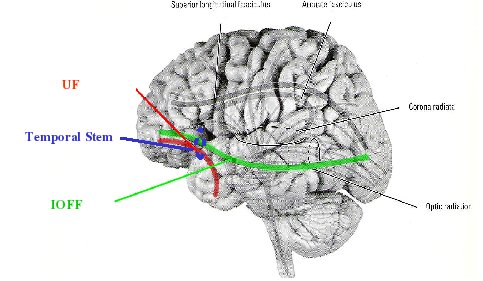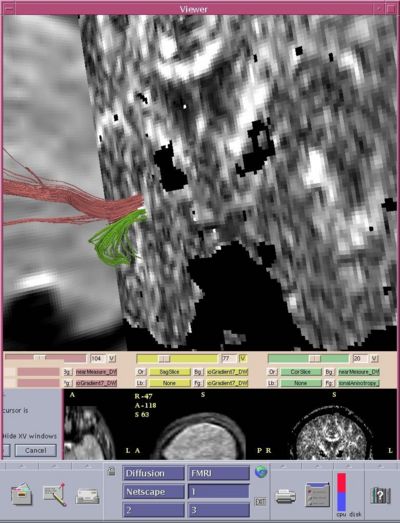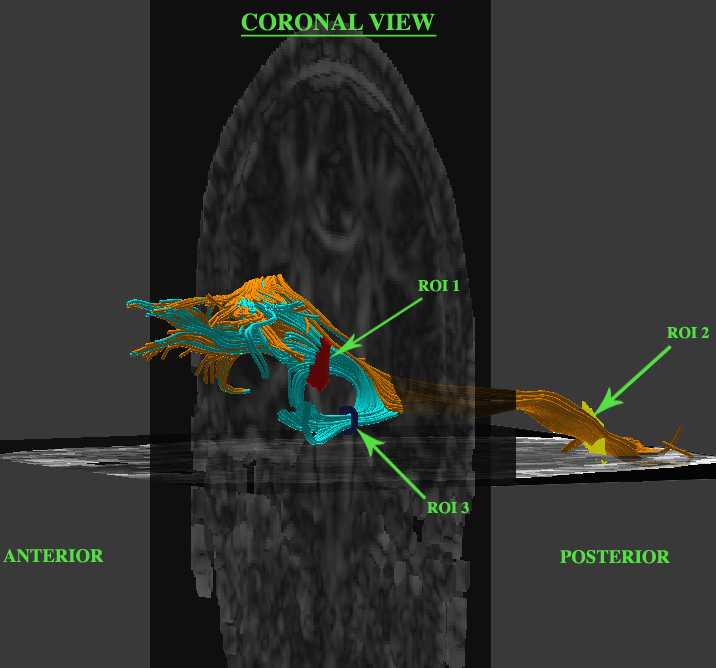Difference between revisions of "Projects:InferiorFrontotemporalConnections"
| (6 intermediate revisions by the same user not shown) | |||
| Line 1: | Line 1: | ||
| − | [[ | + | Back to [[NA-MIC_Collaborations|NA-MIC_Collaborations]], [[Algorithm:MIT|MIT Algorithms]] |
| + | __TOC__ | ||
| − | + | = Inferior Frontotemporal Connections = | |
| + | |||
| + | Our objective is to use fiber tractography in order to investigate inferior fronto-temporal connections in schizophrenia. | ||
| − | == | + | = Description = |
| − | |||
| − | + | We followed up the ROI analysis of UF in chronic patients, in 27 chronic schizophrenics and 34 controls using a fiber-tracing method to estimate FA along the entire tract. We used two region-of-interest (ROI) extraction method, where we extracted fiber tracts traveling between two, manually drawn ROIs. First ROI was placed in the area previously investigated in our UF paper (Kubicki et al., 2002), second and third ROIs were placed within the temporal pole white matter, and posterior temporal white matter respectively. This resulted in two tracts, both traveling through the temporal stem, but separating their paths shortly after (Uncinate Fasciuclus (UF) and Inferior Occipito-Frontal Fasciuclus (IOFF)). | |
| − | |||
| − | + | After fiber tract extraction, we calculated mean FA along the tracts, as well as length, number of fibers and mean curvature of each bundle, and compared them between groups. Post-hoc t-tests revealed that mean FA in patients was not significantly different from controls on either left (P(1,59)=0.900) or right UF (P(1,59)=0.612). IOFF, from the other hand, turned out to be abnormal in schizophrenia on both the left (P(1,59) = 0.019), and right (P(1,59) = 0.031) side, confirming the fiber tractography to be a better tool for tract delineation, and pointing to the need for further investigation in order to fully understand the relationship between this area and schizophrenia abnormalities. In addition, reduced UF integrity, strongly correlated with negative symptoms that often typify social communication disturbance in schizophrenia. Specifically, lower left UF FA correlated with more severe active social avoidance, (rho(25)=-.522, p<.01) as well as lack of spontaneity and flow of conversation rho(26)=-.546, p<.01, while higher symptom ratings indicative of greater severity for anhedonia-asociality correlated significantly with lower right UF integrity (rho(25)=.513, p<.01), as did poorer eye contact with lower right UF integrity (rho(25)=-.597, p<.01). | |
| − | + | [[image:frontotemporal.jpg]] | |
| − | + | [[image:frontotemporal_tracts.jpg|400px]] | |
| − | + | [[image:frontotemporal_tracts2.jpg]] | |
| + | = Key Investigators = | ||
| − | + | * Harvard PNL: Marek Kubicki, Georgia Bushell, Doug Markant, Marc Niethammer, Martha Shenton | |
| + | * MIT: Raul Estapar, Carl-Fredrik Westin | ||
Latest revision as of 18:28, 27 November 2007
Home < Projects:InferiorFrontotemporalConnectionsBack to NA-MIC_Collaborations, MIT Algorithms
Inferior Frontotemporal Connections
Our objective is to use fiber tractography in order to investigate inferior fronto-temporal connections in schizophrenia.
Description
We followed up the ROI analysis of UF in chronic patients, in 27 chronic schizophrenics and 34 controls using a fiber-tracing method to estimate FA along the entire tract. We used two region-of-interest (ROI) extraction method, where we extracted fiber tracts traveling between two, manually drawn ROIs. First ROI was placed in the area previously investigated in our UF paper (Kubicki et al., 2002), second and third ROIs were placed within the temporal pole white matter, and posterior temporal white matter respectively. This resulted in two tracts, both traveling through the temporal stem, but separating their paths shortly after (Uncinate Fasciuclus (UF) and Inferior Occipito-Frontal Fasciuclus (IOFF)).
After fiber tract extraction, we calculated mean FA along the tracts, as well as length, number of fibers and mean curvature of each bundle, and compared them between groups. Post-hoc t-tests revealed that mean FA in patients was not significantly different from controls on either left (P(1,59)=0.900) or right UF (P(1,59)=0.612). IOFF, from the other hand, turned out to be abnormal in schizophrenia on both the left (P(1,59) = 0.019), and right (P(1,59) = 0.031) side, confirming the fiber tractography to be a better tool for tract delineation, and pointing to the need for further investigation in order to fully understand the relationship between this area and schizophrenia abnormalities. In addition, reduced UF integrity, strongly correlated with negative symptoms that often typify social communication disturbance in schizophrenia. Specifically, lower left UF FA correlated with more severe active social avoidance, (rho(25)=-.522, p<.01) as well as lack of spontaneity and flow of conversation rho(26)=-.546, p<.01, while higher symptom ratings indicative of greater severity for anhedonia-asociality correlated significantly with lower right UF integrity (rho(25)=.513, p<.01), as did poorer eye contact with lower right UF integrity (rho(25)=-.597, p<.01).
Key Investigators
- Harvard PNL: Marek Kubicki, Georgia Bushell, Doug Markant, Marc Niethammer, Martha Shenton
- MIT: Raul Estapar, Carl-Fredrik Westin


